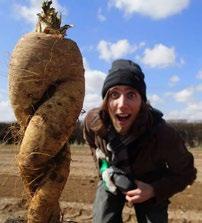
1 minute read
GLEANING NETWORK FEEDING THE 5000
PROJECT NAME
ORGANISATION /GROUP
GLEANING NETWORK FEEDING THE 5000 www.feeding5k.org
Gleaning Network UK harnesses ‘Feeding the 5000’s’ national profile, large network of volunteers and close links with farmers around the country to provide an effective mechanism to divert wasted fruit and vegetables from farms to charities to provide food to the most vulnerable groups in society.
The project provides giving opportunities for hundreds of people, who are encouraged to volunteer on regular gleaning days in the countryside.
Innovation
Gleaning Network demonstrates innovation in two ways. Gleaning hubs are designed to bring together local communities of volunteers, growers and charities to create a grassroots movement connecting people of all ages back to the countryside in which they live. At the same time, working to catalyse change on a national and international level by engaging the media to secure public interest and support, and through extensive face–to–face consultation with government departments, NGOs and some of the largest food retailers in the world.
Impact
In total 36,744 kg of food was collected by the Gleaning Network. Approximate net saving of 101,607kg of CO2 eq. (101.6 tonnes of CO2 eq). 208 volunteers took part in Gleaning days. 670 new volunteers added to the Gleaning Network UK database.
Other Social Impacts
At least ten redistribution charities and companies have distributed gleaned produce to beneficiary charities, low income families and schools.
Approximately 350 beneficiary charities have received produce providing 16,500 beneficiaries with a meal every day by FareShare depots that received gleaned produce from Gleaning Network UK.
During the pilot
16 Gleaning days. Providing 183,720 meals to beneficiaries. Worked with 11 farms. Worked with ten charity depots in six counties.
The Future
The team are exploring options for generating income. Some ideas are focused on a model, of converting ‘unwanted’ fruit and vegetables into value–added products.
They expect to be able to directly move upwards of 80,000 kg of produce per year from farm level back into the human food system per year in Years two and three, and more as the project develops.
The highlights were both the social element (doing something good with a group of people), and the personal/wildlife element (doing something physical in the outdoors, interacting with plant life). I couldn’t choose which I loved more!
Volunteer, plum and apple gleaning










